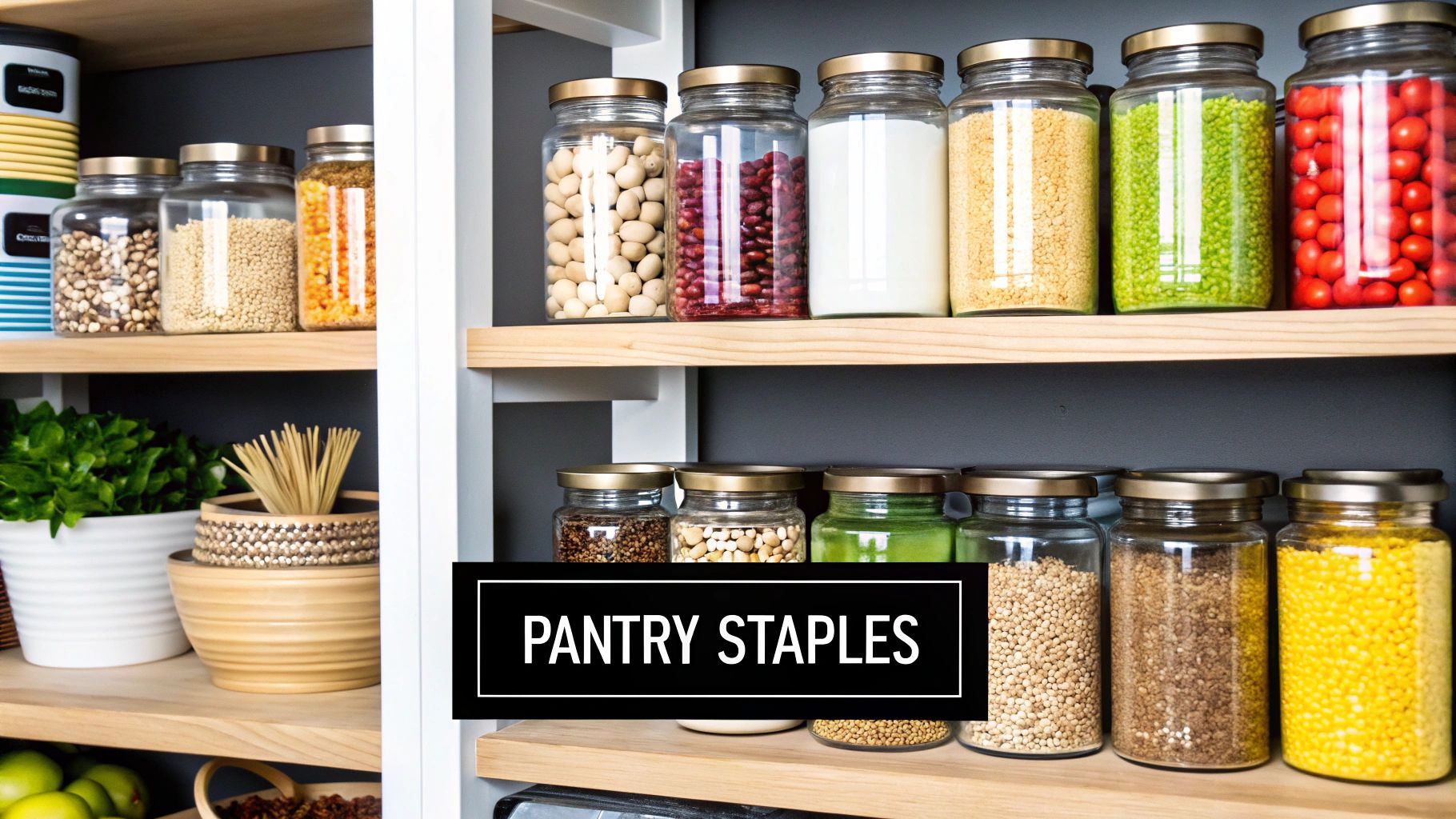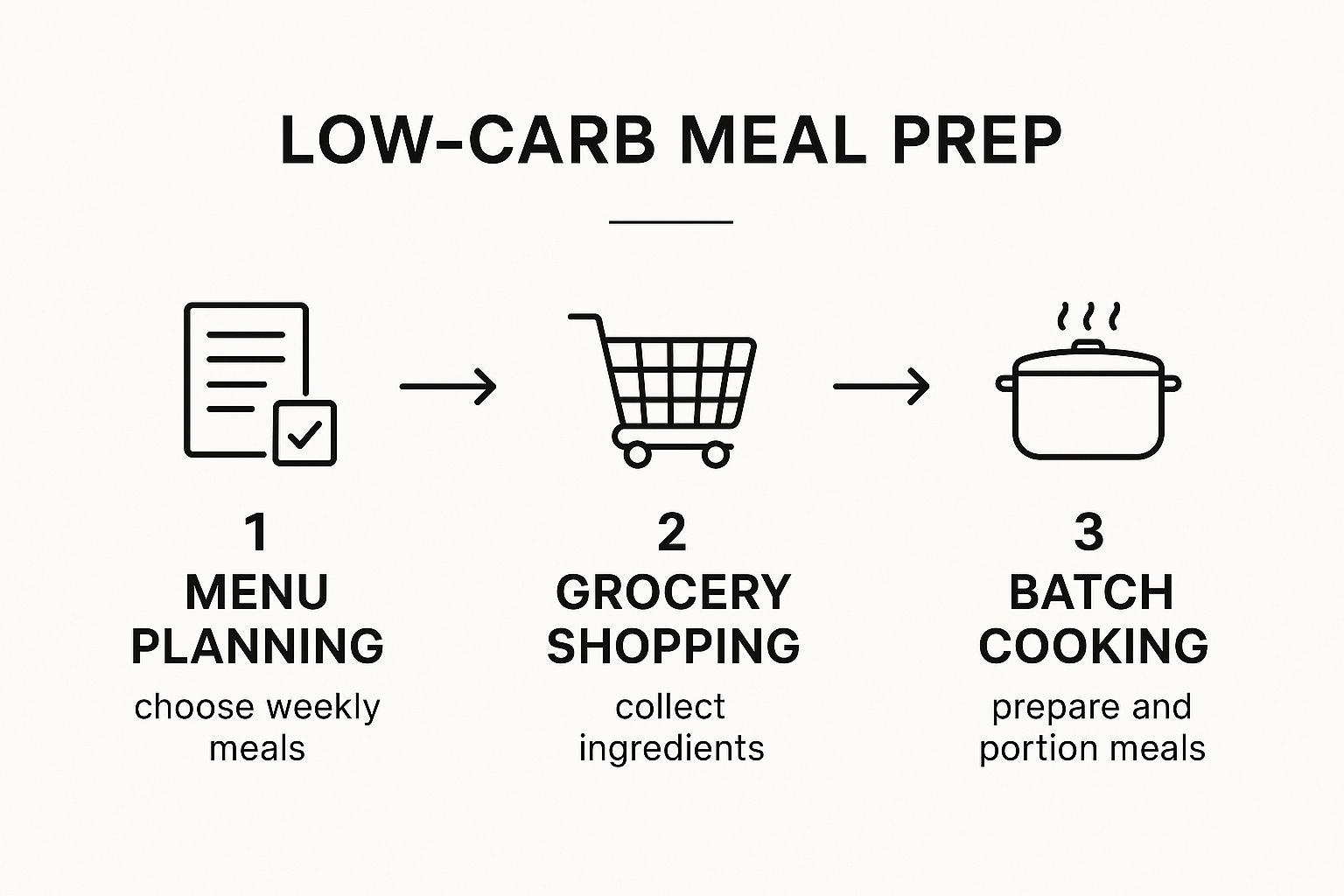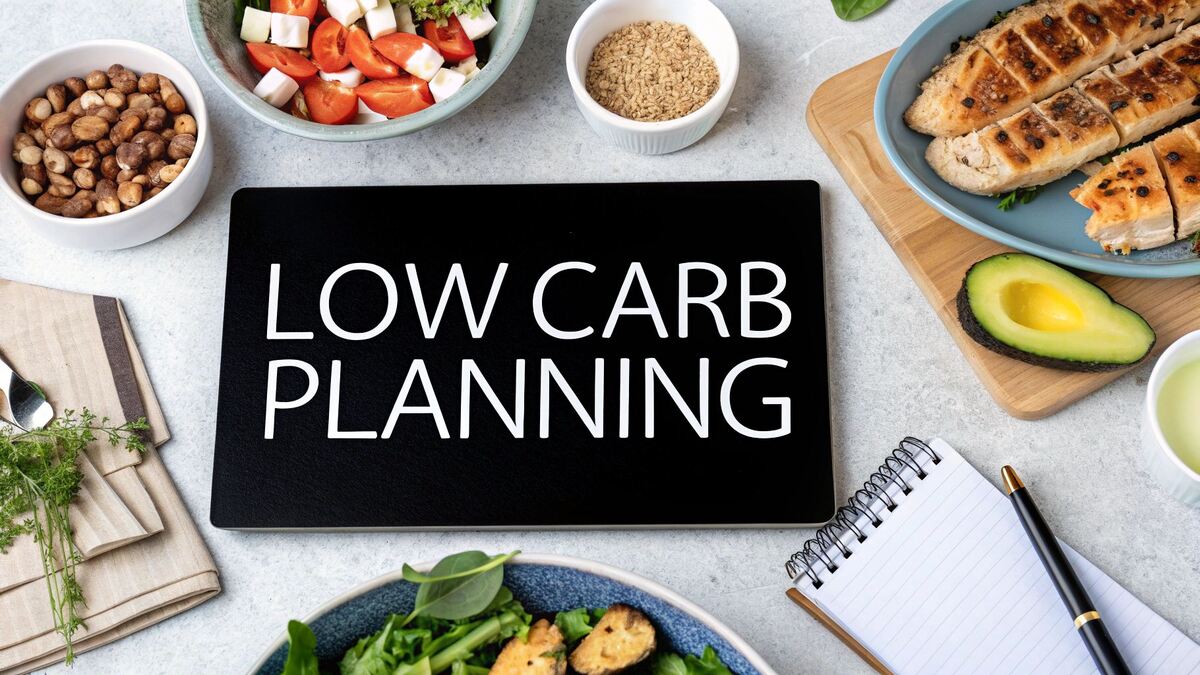Your Guide to Low Carb Meal Planning
Let's be real: trying to stick to a low-carb way of life without a plan is a recipe for disaster. Think of low carb meal planning as your secret weapon. It's what keeps your energy steady, supports your metabolic health, and stops you from caving to carb-heavy cravings at the last minute.
This isn't about creating some super-rigid, joyless eating schedule. It’s about building a flexible system that actually fits your life.
Why Meal Planning Is Your Secret Weapon
Winging it rarely works, especially when you're cutting carbs. We’ve all been there—you get home late, you're absolutely starving, and the takeout menu on the fridge suddenly looks like the most beautiful thing you've ever seen. This is exactly where planning ahead changes the game, turning vague health goals into a concrete, daily reality.
When you have a solid plan, you eliminate the daily "what's for dinner?" panic. Instead of scrambling, you have a clear roadmap of delicious, low-carb meals ready to go. It’s a simple shift, but it gives you an incredible sense of control over your nutrition and well-being.
The Real Benefits of a Low Carb Plan
Once you get into the groove of planning your meals, you start to see some fantastic benefits unfold:
- No More Energy Slumps: You get to skip the blood sugar rollercoaster that carb-heavy meals create. The result? Consistent, stable energy that carries you through your entire day.
- A Boost for Your Metabolism: Eating low-carb on a consistent basis can do wonders for improving insulin sensitivity and helping you hit your weight management targets.
- Less Brain Drain: Deciding what to eat multiple times a day is mentally exhausting. A meal plan takes that burden off your plate, freeing up your mental energy for more important things.
And it's not just a niche trend anymore. The global low-carb diet market was valued at around USD 14.55 billion in 2024 and is expected to climb to USD 22.25 billion by 2032. This growth is all about a growing awareness of how effective this approach is for managing weight and improving metabolic health. If you're curious, you can explore more about these market trends and their drivers.
The goal isn’t perfection; it’s consistency. A good-enough plan that you stick with is far better than a perfect plan you abandon after three days.
At the end of the day, planning is your strategy for success. It’s the framework that makes your healthy choices easier, keeps you on track, and turns the low-carb lifestyle into something that’s not just doable, but genuinely enjoyable for the long haul.
Finding Your Personal Low Carb Approach

Before you even think about recipes, we need to figure out what "low carb" actually means for you. It’s a huge umbrella term, covering everything from super-strict keto to a much more relaxed style of eating. Nailing down your personal carb target is the absolute foundation of your entire meal plan.
Think of it this way: you wouldn't start a road trip without a destination. Your "why" for going low-carb determines your daily carb limit. Someone managing their blood sugar, for instance, will have a very different daily goal than an athlete trying to lean out without tanking their performance.
Defining Your Daily Carb Target
So, what’s a good number to aim for? Generally, a low-carb diet involves eating between 20 to 150 grams of carbs per day. That’s a pretty big drop from the standard dietary recommendation of 225-325 grams on a 2,000-calorie diet.
To find your starting point, let's look at the common ranges:
- Strict Ketogenic (under 20-50g/day): This is the most restrictive approach. The goal here is to get your body into ketosis, where it starts burning fat for energy. It's often used for specific health goals or fast initial weight loss, but it takes serious commitment and tracking.
- Moderate Low Carb (50-100g/day): This is my favorite spot for most people. It gives you more breathing room for a wider variety of vegetables and even small amounts of fruit. It’s a sustainable, long-term approach for general health and managing your weight.
- Liberal Low Carb (100-150g/day): This is perfect if you're very active or are just looking to maintain your current weight. You'll still cut out the processed junk and sugars, but you can comfortably include more starchy veggies and fruit.
Your ideal carb count isn't set in stone. The best number is the one that makes you feel fantastic—energetic, satisfied, and clear-headed—while still moving you toward your goals.
Listening to Your Body's Feedback
Once you've picked a starting point, the real work begins. You have to pay close attention to how your body responds. Are you hitting a wall at 3 p.m.? Are cravings driving you crazy? These aren't signs of failure; they're signals that you might need a small adjustment.
For example, say you start at 50g of carbs per day but feel totally gassed during your workouts. You could try adding 15-20g of carbs from something like a small sweet potato about an hour beforehand and see how you feel. On the flip side, if your weight loss has stalled on a 100g plan, maybe dialing it back to 75g for a couple of weeks is the tweak you need to get things moving again.
This constant process of fine-tuning is what turns a generic "diet" into a personalized way of eating that truly works for you. Long-term success isn't about white-knuckling your way through a restrictive plan; it's about building a sustainable framework that feels good for your body.
Building Your Go-To Recipe Collection

Let’s be honest, no low-carb meal plan survives on willpower alone. The real key to success is having a stash of delicious, reliable recipes you actually want to eat. This isn't about deprivation; it's about building your own personal cookbook of go-to meals that make sticking to your plan feel easy, not like a chore. This is your first line of defense against the siren song of last-minute takeout.
Your collection should have a good mix of options. You'll want some 20-minute wonders for those crazy weeknights, but also a few more satisfying, leisurely meals for the weekend. Variety is what keeps things interesting and prevents you from falling into a food rut.
Finding and Organizing Your Recipes
So, where do you find these magical recipes? Start by exploring sources you trust. Food blogs, Pinterest, and dedicated low-carb cooking sites are fantastic places to get inspired. The trick is to have a system for saving the good ones as you find them.
A digital approach is often the easiest. I've seen people have great success with apps like Paprika, but even a simple Pinterest board organized by meal type works wonders.
- Breakfasts: Think beyond scrambled eggs. Look for baked egg muffins, chia seed pudding, or protein-packed smoothies you can prep ahead.
- Lunches: Big salads with grilled chicken, creative lettuce wraps, or hearty soups are perfect for making in batches.
- Dinners: One-pan meals are a lifesaver. Think sausage and peppers, sheet pan salmon with asparagus, or a quick stir-fry.
Having this kind of structure is a huge part of effective low carb meal planning. Once you have a handful of solid recipes in each category, you’ll be amazed at how easily you can mix and match them to build out a full week of meals.
Adapting Your High-Carb Favorites
Going low-carb doesn't mean you have to break up with your favorite comfort foods. This is where you get to be a little creative and learn how to make some smart swaps. It’s actually one of the most empowering parts of the process.
For instance, if you're a pasta lover, try swapping in zucchini noodles ("zoodles") or spaghetti squash for your bolognese. Got a craving for pizza? A cauliflower crust or a "meatzza" (a crust made from ground meat) can be incredibly satisfying. Simple switches like using mashed cauliflower instead of potatoes or almond flour for breading can completely change the game. In fact, our AI Meal Planner often helps people discover these kinds of exciting alternatives they hadn't thought of.
The real secret to making this a long-term lifestyle is to make it feel like an upgrade, not a restriction. When you can still enjoy your version of taco night or lasagna, you're so much more likely to stick with it.
It's also crucial to remember nutrient density. Low-carb diets are incredibly popular—the number of adults following them in the U.S. has doubled in the last decade. But some research shows that if you're not careful, you can fall short on things like fiber, potassium, and certain vitamins. That's why building a recipe collection full of non-starchy vegetables is so critical for your overall health. If you're curious about the details, you can read the full study findings on nutrient intake and see why a well-rounded plan matters so much.
Creating Your Smart Shopping List
Once you've got your recipes picked out, it's time to turn that meal plan into your best tool for success: the shopping list. This is more than just a reminder to buy avocados. A really good list keeps you focused, saves you money, and helps you get through the grocery store without getting sidetracked by all the junk in the middle aisles.
I've found the best way to do this is to have two lists. First, a "master list" of all your go-to pantry items. Second, a fresh weekly list for things like produce and meat. This two-list system makes your weekly shopping trips way faster and guarantees you've always got what you need for a quick low-carb meal.
Building Your Low Carb Pantry Foundation
Think of your pantry as your first line of defense. When it’s stocked with versatile, long-lasting low-carb foods, you’ll always have the ingredients for a solid meal. This is a huge part of making low carb meal planning something you can stick with long-term.
Here are the staples you'll want to have on hand:
- Healthy Fats and Oils: I always keep avocado oil, extra virgin olive oil, and coconut oil around. They're perfect for everything from searing a steak to whipping up a salad dressing.
- Nuts and Seeds: Almonds, walnuts, chia seeds, and flax seeds are non-negotiable. They're great for a quick snack, for adding crunch to a salad, or even for making a low-carb version of oatmeal.
- Spices and Seasonings: A good spice rack is what keeps low-carb from getting boring. If you don't have them already, grab some garlic powder, onion powder, smoked paprika, and a good Italian seasoning blend.
- Low-Carb Flours: To satisfy those baking cravings, you'll need almond flour and coconut flour. They're key for making keto-friendly breading or baked goods.
A well-stocked pantry is like an insurance policy for your diet. When you have the basics on hand, you're far less likely to order a pizza out of desperation.
Crafting Your Weekly Fresh List
With your pantry essentials covered, your weekly shopping list gets a lot shorter and easier to manage. The trick here is to organize it by the layout of your grocery store. I always group my items—produce, meat, dairy—so I’m not running back and forth across the store, which is when those impulse buys tend to happen.
For example, a typical weekly list of mine might look something like this:
- Produce Section:
- Spinach and arugula for salads
- Broccoli and cauliflower for roasting
- Bell peppers and zucchini for stir-fries
- A small container of berries
- Meat and Seafood:
- A pack of chicken thighs for batch cooking
- Ground beef for lettuce wraps or burgers
- A couple of salmon fillets for a quick weeknight dinner
- Dairy and Refrigerated:
- Eggs (the ultimate low-carb superstar)
- Heavy cream for sauces
- Unsweetened almond milk
- Plain Greek yogurt or full-fat cottage cheese
This organized method doesn’t just save time; it keeps you locked into your plan. To help you get started, I’ve put together a quick-reference guide for stocking your kitchen with the right stuff.
Essential Low Carb Foods by Category
This table is a simple cheat sheet to help you quickly identify the best food choices as you build your shopping list.
| Category | Excellent Choices | Good in Moderation |
|---|---|---|
| Proteins | Chicken (especially thighs/wings), grass-fed beef, fatty fish (salmon, sardines), eggs, pork, lamb, seafood, tofu. | Cured meats (bacon, sausage), full-fat cheeses. |
| Non-Starchy Vegetables | Leafy greens (spinach, kale), broccoli, cauliflower, bell peppers, asparagus, zucchini, avocado, cucumbers. | Onions, tomatoes, carrots, Brussels sprouts. |
| Healthy Fats | Avocado oil, extra virgin olive oil, coconut oil, nuts (almonds, macadamia), seeds (chia, flax), olives. | Butter from grass-fed cows, Ghee, MCT oil, full-fat dairy. |
| Dairy | Unsweetened Greek yogurt, full-fat cottage cheese, unsweetened nut milks, sour cream. | Heavy cream, cream cheese, hard cheeses (cheddar, parmesan). |
Keeping a list like this in mind makes it almost automatic to fill your cart with nutrient-dense foods that support your goals without having to second-guess every item.
Mastering Your Weekly Meal Prep
Alright, you've got your recipes and a shopping list. Now for the fun part—the prep session. This is where the magic happens, turning your plan into a fridge stocked with grab-and-go low-carb meals. And don't worry, this doesn't mean you're stuck in the kitchen all day Sunday.
The real goal here is to find a prep rhythm that works for you. You don’t have to cook every single meal from scratch for the entire week. A little bit of focused work now will save you from those frantic, carb-filled decisions on a busy Tuesday night. Trust me, it pays off.
Choosing Your Meal Prep Style
There's no one-size-fits-all approach to meal prep. The best method is simply the one you'll actually do consistently. Take a hard look at your schedule and your typical energy levels. Do you prefer one big cooking marathon, or are smaller, bite-sized tasks more your speed?
Here are a few of the most popular ways people tackle this:
- Batch Cooking Components: This is my personal go-to because it offers so much flexibility. I'll cook up key ingredients in big batches—think grilling a family pack of chicken thighs, roasting a giant sheet pan of broccoli and bell peppers, or hard-boiling a dozen eggs. Throughout the week, I can mix and match these core components to build different meals, which keeps things from getting boring.
- Assembled Grab-and-Go Meals: If your mornings are a blur or you need a foolproof lunch option, this is for you. You fully assemble individual meals, like layered salads in a jar or portioned-out containers of steak and roasted cauliflower. When it's time to eat, you just grab it and go.
- Ingredient Prep Only: Feeling overwhelmed by the thought of cooking everything at once? Start here. Just do the chopping. Wash and slice all your veggies, marinate your proteins, or whip up a big batch of your favorite salad dressing. This step alone can slash your daily cooking time in half.

As you can see, the whole process is a logical flow. You plan the menu, you batch cook the components, and the rest of the week just falls into place.
A Real-World Sunday Prep Session
Let's make this real. Say you have about two hours on a Sunday afternoon. Here’s how you could easily prep the bulk of your weekday lunches and dinners.
First, get the longest task going. I always start with the oven. Crank it up to 400°F (200°C). While it preheats, I'll toss a pound of broccoli and a sliced bell pepper with some avocado oil and seasoning, then get them roasting on a baking sheet for about 20-25 minutes.
While the veggies are in the oven, it's time to tackle the protein. I'll get a pound of ground beef browning in one skillet for taco salads or lettuce wraps. At the same time, I might sear four chicken thighs in another pan to slice up for salads later.
As the meats are cooking, I'll move on to the fresh prep. This is the perfect time to wash and chop a head of lettuce, slice up a cucumber for snacks, or portion out some almonds into little bags.
The secret to efficient meal prep is multitasking. You should always have something going in the oven while you're working on the stovetop and chopping fresh ingredients. Stacking your tasks like this is how you get an incredible amount done in a short period.
Once everything is cooked, don't skip this final, crucial step: let all the hot food cool down completely before you pack it away. Putting warm food into airtight containers in the fridge creates condensation, which leads to soggy food. A little patience here ensures everything stays fresh and delicious all week long.
Your Low-Carb Meal Planning Questions, Answered
Starting a low-carb journey is a fantastic move, but let's be real—it comes with questions. How do you handle a dinner invitation without panicking? What do you do when the 3 PM snack cravings hit? And how do you keep from getting bored with the same old meals?
Don’t worry, these are completely normal hurdles. I've been there. This section is all about giving you clear, practical answers to the most common challenges people face. Think of it as a field guide to navigating the real world while staying on track.
How Do I Handle Eating Out Or Social Events?
Going out to eat shouldn't feel like a test you have to cram for. With a little bit of prep, you can enjoy yourself without derailing your progress. The single best thing you can do is look at the menu online before you even leave the house. Seriously, this one move takes all the pressure off.
Once you’re there, keep it simple. Look for grilled, roasted, or baked proteins and ask for a double serving of non-starchy veggies on the side. And never, ever be afraid to make a special request.
- Ask for steamed vegetables instead of the standard fries or potato.
- Always get sauces and dressings on the side. You'll be amazed at the hidden sugar in some of them.
- Go for a bunless burger or a simple steak with a side salad.
These little tweaks are game-changers. They let you focus on the conversation and the company, not on stressing over your plate.
What Are The Best Low-Carb Snacks To Keep On Hand?
Let's be clear: snacks are your friend. They're the secret weapon in your low-carb meal planning arsenal, stopping you from getting so hungry you'll eat anything in sight. The trick is having the right things ready to grab.
Stock your kitchen (and your car, and your desk) with portable, satisfying options. Hard-boiled eggs, cheese sticks, and single-serving packs of almonds or walnuts are fantastic. For savory cravings, things like olives, pork rinds, or quality beef jerky are lifesavers.
A solid list of go-to snacks is your best defense against that afternoon energy crash. The goal isn't to stop snacking—it's to start snacking smarter.
Is It Possible To Do Low-Carb Meal Planning On A Budget?
Yes, absolutely. A low-carb lifestyle does not have to break the bank. You just need to be a little strategic with your shopping list.
The key is to build your meals around affordable proteins and produce. Chicken thighs, ground beef, and eggs are nutritional powerhouses that are also kind to your wallet. For vegetables, always buy what’s in season—it's almost always cheaper. And don't sleep on the freezer aisle! Frozen spinach, broccoli, and berries are just as nutritious as fresh and often cost a lot less.
This shift toward healthier eating isn't just a personal choice; it's a massive market trend. The low-fat and low-carb food market is projected to skyrocket from USD 6.1 billion in 2025 to a staggering USD 11.8 billion by 2035. If you're curious about the numbers behind this movement, you can discover the full consumer demand insights and see what's driving the growth.
How Can I Avoid Getting Bored With My Meals?
Meal fatigue is a real thing, but you can totally avoid it. The easiest way to keep your taste buds happy is to consciously introduce new things into the rotation.
Try this: commit to making one new low-carb recipe every single week. It’s a small goal, but it’s enough to build up a collection of new favorites over time. Another great tactic is to simply rotate your proteins and experiment with different herbs, spices, and sugar-free sauces. A new spice blend can make a chicken breast feel like a brand-new meal. Think of your plan as a flexible guide, not a prison sentence.
Ready to take the guesswork out of meal planning for good? The AI Meal Planner builds delicious, personalized low-carb meal plans that fit your goals and tastes perfectly. Stop stressing and start enjoying healthy food designed just for you. Get started with your custom meal plan today.
AI-powered nutrition
Get Your Personalized Meal Plan
AI creates the perfect meals for your goals, lifestyle, and taste.
Start Your Journej
